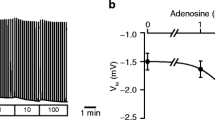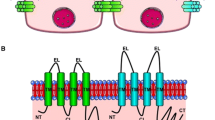Abstract
Epithelial cells of exocrine glands (pancreas, lacrimal glands, salivary glands, sweat glands and gastric glands) are intimately linked together by gap junctions. Due to this close junctional coupling exocrine secretion occurs as the well concerted effort of a cell population. Colonic crypts have, on the one hand, anatomical and functional properties resembling those of exocrine glands (mostly crypt base cells) and, on the other hand, properties of absorbing cells (mostly surface cells). In the mid-crypt, depending on the functional status, absorption and secretion can occur. The present study was aimed at examining whether rat distal colonic crypt cells co-ordinate their functional status by cell-to-cell coupling. Two types of measurements were performed: as an independent assessment of cell viability the membrane voltage (V m) was measured with the fast whole-cell patch-clamp technique; to investigate cellular coupling simultaneously Lucifer Yellow (LY) (mol. wt. 443) distribution was visualized using digital video imaging. LY (500 μmol/l) was included into the patch pipette filling solution. The recorded V m was –73.4±2.3 mV in crypt base cells (n=15), –63.7±2.1 mV in mid-crypt cells (n=17) and –52.3±2.9 mV in crypt surface cells. All cells tested reversibly responded to carbachol (100 μmol/l) with a persistent hyperpolarization, as previously shown. Activation of Cl- secretion by elevation of the cAMP concentration with forskolin (5 μmol/l) led to a reversible depolarization. Throughout the duration of each individual experiment [mean experimental time in basal cells: 18.3±2.5 min (n=15), in mid-crypt cells: 19.6±3.4 min (n=17) and in crypt surface cells: 11.7±3.4 min (n=13)] LY dye distribution was solely confined to the patched cell. In addition bleaching of calcein fluorescence in laser scan microscopy was not followed by dye back diffusion, whereas this was clearly the case in pancreatic acini (n=5). These data indicate that colonic crypt cells are not coupled by gap junctions under resting conditions or in the presence of secretagogues.
Similar content being viewed by others
Author information
Authors and Affiliations
Additional information
Received: 24 June 1997 / Received after revision: 28 November 1997 / Accepted: 16 December 1997
Rights and permissions
About this article
Cite this article
Jacobi, C., Leipziger, J., Nitschke, R. et al. No evidence for cell-to-cell coupling in rat colonic crypts: studies with Lucifer Yellow and with photobleaching. Pflügers Arch 436, 83–89 (1998). https://doi.org/10.1007/s004240050607
Issue Date:
DOI: https://doi.org/10.1007/s004240050607




